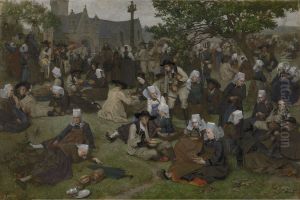Henri Pille Paintings
Henri Pille was a French illustrator and painter, known for his genre scenes, historical illustrations, and social satires. Born on January 14, 1844, in Chantilly, France, Pille grew up during a period that was rich with artistic evolution and social change. He began his artistic education at the École des Beaux-Arts in Paris, where he studied under the tutelage of esteemed artists such as Isidore Pils and Henri Lehmann.
Pille's work was characteristic of the Third Republic era in France, where illustrative art was gaining prominence alongside the burgeoning print media industry. As a skilled draftsman, he contributed to various publications including 'Le Monde Illustré', 'L'Illustration', and 'Le Journal Amusant'. His illustrations often included commentary on the social and political issues of his time, which allowed him to gain recognition for both his artistic talents and his insightful perspectives on contemporary life.
Throughout his career, Pille also dedicated himself to painting. His genre paintings often depicted scenes of everyday life, imbued with a sense of realism and a narrative quality. He had a keen eye for detail and a talent for capturing the nuances of human expression and interaction. Pille exhibited his works at the Paris Salon, where he received commendations for his contributions to French art.
In addition to his genre scenes and illustrations, Henri Pille was also known for his historical paintings. He had a particular interest in the Middle Ages and the Renaissance, which was reflected in his works that often portrayed historical figures and events with a dramatic flair. His historical illustrations not only served as visual entertainment but also as educational material, helping to popularize French history among the masses.
Henri Pille's life was cut short when he passed away on October 3, 1897, at the age of 53. Despite his relatively brief career, he left behind a legacy that encapsulated the spirit of his time. His works continue to be appreciated for their historical value and artistic merit, providing a window into the cultural and social fabric of 19th-century France.




